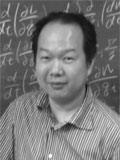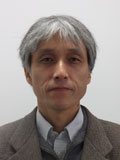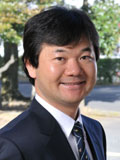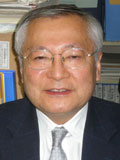Open-type researchers A01: Exploration (the latter period)
Shuji Akiyama
| Research Center of Integrative Molecular Systems (CIMoS), Institute for Molecular Science (IMS), National Institutes of Natural Sciences (NINS), Professor, Ph. D. |
 |
|
| Role: | A01 Open-type Researcher | |
|---|---|---|
| Title: | Complementary use of small-angle X-ray scattering and high-speed AFM for tracking assembly/disassembly dynamics of molecular systems | |
| Co-Investigator (renkei-kenkyusha): | Takayuki Uchihashi Faculty of Mathematics and Physics, Institute of Science and Engineering Kanazawa University, Professor, Ph. D. |
|
| Atsushi Mukaiyama Research Center of Integrative Molecular Systems Institute for Molecular Science, Assistant Professor, Ph. D. |
||
| Purpose: | Flexibility and adaptability are important characteristics of life, originating as consequences of dynamic and cooperative behaviors of bio-macromolecules in cells. In this research project, we will use small-angle x-ray scattering and high-speed AFM complementary as tools to measure ordered motions of circadian clock proteins in cyanobacteria, with an ultimate goal of understanding the mechanisms behind circadian periodicity and temperature compensation in biological clock systems. | |
Ryo Akiyama
| Department of Chemistry, Kyushu University Associate Professor, Ph. D. |
 |
|
| Role: | A01 Open-type Researcher | |
|---|---|---|
| Title: | Phase behaviors and dynamic ordering and regulation based on effective attraction mediated by multivalent cations | |
| Purpose: | Motion of cell, such as amoeboid movement, is driven by anchoring and association of actin-like proteins. We will understand those dynamical ordering structures on the basis of statistical physics. The first step is studies of the phase behaviors. They are studied by using molecular simulation method. The effective interaction is calculated by using an integral equation theory. One of the purposes in this subject is an elucidation of actin treadmilling and of the regulation mechanism, because it is important process in the cell movement. Here, the treadmilling means directional motion of actin-filament. In the treadmilling process, an end of protein filament grows by the association of monomer proteins and the dissociation causes the shrink at the other end of filament. Consequently, the directional motion is observed. Experiments have shown that multivalent cations mediate effective attraction between acidic proteins. We think that actin-actin attraction arises from this interaction and the strength is regulated by the ATP-hydrolysis. To discuss the regulate mechanism we need the phase behaviors and the simulations prepare them and the structure. The other purpose is a survey of the application of this idea. There are some attractive patches, such as negatively charged oxygen atoms, on the acidic proteins. The dynamical ordering structure of proteins can depend on the arrangement of the patches. We will study the dependence based on the simulation studies with above idea. |
|
Teppei Ikeya
| Graduate School of Science, Tokyo Metropolitan University Assistant Professor, Ph. D. |
 |
|
| Role: | A01 Open-type Researcher | |
|---|---|---|
| Title: | Dynamics and stability of protein structures obtained by an organized system in living cells | |
| Co-Investigator (renkei-kenkyusha): | Yutaka Ito Graduate School of Science, Tokyo Metropolitan University, Professor, Ph. D. |
|
| Peter Güntert Graduate School of Science, Tokyo Metropolitan University, Guest Professor Ph. D. |
||
| Purpose: | In order to understand the dynamic ordering of biomacromolecules under nearly natural conditions, it is necessary to directly observe those three dimensional (3D) structures and dynamics at work in living cells. Most of the past analyses of protein structure and dynamics, however, were performed in dilute solutions with purified samples, which were far from living systems conducting the dynamical ordering and functions. We developed several methods to analyze proteins at atomic resolution in living cells using an approach named in-cell NMR, including the first protein 3D structure determination in cells. Extending these technologies, it should be possible to elucidate the relationships between protein function and dynamical ordering in the cell. In this research project, we will attempt to measure the interaction of a target protein with other proteins inside the cells as well as its molecular dynamics and structure, in order to reveal the mechanism by which the molecular functions and structures are invoked in these complex systems. | |
Koichi Iwata
| Department of Chemistry Gakushuin University Professor, Ph. D. |
 |
|
| Role: | A01 Open-type Researcher | |
|---|---|---|
| Title: | Experimental examination of domain structure in artificial lipid bilayer membranes | |
| Co-Investigator (renkei-kenkyusha): | Tomohisa Takaya Department of Chemistry, Gakushuin University Assistant Professor, Ph. D. |
|
| Purpose: | A number of biochemical reactions proceed at biomembranes, catalyzed by membrane proteins. The structure of the biomembranes and its fluctuation affect the biochemical reactions that proceed there in a crucial manner. Although the biomembranes have been studied extensively, their molecular structure and the dynamic behavior are still to be clarified. An increasing number of researchers presume the presence of the “lipid raft”. The lipid raft model implies that there is structure similar to the gel phase membrane and structure similar to the liquid-crystal phase membrane coexisting together in the lipid bilayer membrane. Or, there is a domain structure in the lipid bilayer membrane. The aim of this study is to examine the presence of the domain structure in the lipid bilayer membrane by using advanced spectroscopic methods. Lipid molecules must aggregate “properly” for forming a functional biomembrane. We will be able to understand the physiological function of cells from the viewpoint of physical chemistry by examining the structure and its fluctuation of the lipid bilayer membranes. |
|
Takayuki Uchihashi
| Nagoya University, Professor, Ph. D. |
 |
|
| Role: | A01 Open-type Researcher | |
|---|---|---|
| Title: | Elucidating the mechanism of robust circadian rhythm generated by Kai proteins with high-speed AFM | |
| Purpose: | Three Kai proteins (KaiA, KaiB and KaiC) governs the circadian clock in Cyanobacteria and the total phosphorylation level of KaiC oscillates with a circadian rhythm in vitro by incubating the Kai proteins and ATP. The Kai oscillator is known to be a robust system with general characteristics of circadian rhythms; self-sustainable oscillation, temperature compensation and phase synchronization. So far, structural analyses by EM and SAXS have demonstrated that the formation of complexes among the Kai proteins vary during the circadian period. Further, the biochemical studies suggested that the phase synchronization is mediated by monomer exchange between KaiC hexamers. Therefore, it is considered that intermolecular interactions between and within Kai proteins play essential roles to achieve the robust circadian oscillation. However, because of a lack of technique to monitor binding/dissociation events at single molecular lever in real time, it has been hard to understand relationships between dynamic molecular interactions and the circadian rhythm of Kai proteins. Since high-speed atomic force microscopy (HS-AFM) is capable of visualizing molecular assembly and disassembly at single molecular level, it would be a powerful to explore dynamic ordering of molecules. In this research project, we apply the HS-AFM to analyzing some aspects in the molecular interactions between Kai proteins; temperature dependence, cooperative effect within the KaiC hexamer composed of monomers with different phosphorylation states and the monomer exchange and understand the molecular mechanisms generating the robust circadian rhythm of Kai proteins. Also we provide the HS-AFM technique as an observation tool to explore dynamic ordering from artificial supramolecular to protein-complex systems through collaborations within the project. |
|
Toshikazu Takata
| Department of Chemical Science and Engineering, Tokyo Institute of Technology Professor, Ph. D. |
 |
|
| Role: | A01 Open-type Researcher | |
|---|---|---|
| Title: | Control of organization of supramolecular polymers connected by rotaxane linkages | |
| Co-Investigator (renkei-kenkyusha): | Daisuke Aoki Department of Chemical Science and Engineering, Tokyo Institute of Technology Assistant Professor, Ph. D. |
|
| Purpose: | Polymer property changes according to its primary structure or topology like linear, branched, and cyclic ones. However, no polymer is reported so far that can undergo the mutual conversion among these structures as a single molecule. Based on our previous study on the construction and structure control of various supramolecular systems consisting of polymers connected by the rotaxane structure via the mechanical linking, we create block copolymer systems capable of easily changing their primary structures (topologies) by utilizing dynamic nature of the rotaxane linkages introduced at the linking points of plural different polymer chains in this work. Unique morphologies of block copolymers resulted by their self-assembly can be controlled by the topologies of the block copolymers such as linear, branched, star, cyclic, and so on, eventually to create novel dynamic ordering systems based on the rotaxane switches. Namely, we will prepare the dynamic ordering polymer systems where small roaxane switch changes the topology of the block copolymer chain and finally controls not only the polymer material’s surface but also the bulk function and property. The present research will accomplish the construction of novel dynamic ordering systems which provides the stimuli-responsive device and material via deep understanding of biomolecular systems. | |
Masanori Tachikawa
| Graduate School of NanoBioScience, Yokohama City University, Professor, Ph. D. |
 |
|
| Role: | A01 Open-type Researcher | |
|---|---|---|
| Title: | Improvement of quantum simulation methods and techniques for exploring self-assembly mechanism of supra and biomolecular systems | |
| Purpose: | In our research project, we will improve our quantum simulation methods and techniques for exploring self-assembly mechanism of supra and biomolecular systems, with the tight discussion with some experimental research groups. First, we will implement the efficient sampling method for parallel computing, and extend our method to nuclear quantum dynamics. Based on such methods, second, we will employ the simulation for supra and biomolecular systems. The simulations in various solvents will be performed for the hexameric nanocubes of gear-shaped amphiphiles. The simulations of protein with law barrier hydrogen bonding will be carried out by our multi-component method, which can take account of quantum fluctuations of light mass particles. | |
Akira Naito
| Graduate School of Engineering, Yokohama National University Professor, Ph. D. |
 |
|
| Role: | A01 Open-type Researcher | |
|---|---|---|
| Title: | Molecular mechanism of amyloid fibril formation of human calcitonin and glucagon in the membrane environments | |
| Co-Investigator (renkei-kennkyuusha): | Izuru Kawamura Graduate School of Engineering Yokohama National University, Associate Professor, Dr. of Engineering |
|
| Purpose: | Human calcitonin (hCT) and glucagon are known as amyloid forming peptides which are related to amyloid diseases. A variety of biophysical methods such as solid-state NMR, TEM, and MD simulation are used to determine the fibril structure and to investigate the fibrillation mechanism in the atomic resolution. In this research project, first, we determine the three dimensional structure of the fibril in the membrane environments using solid state NMR spectroscopy. Second, we investigate the initial fibril formation processes through a couple of intermediates in the membrane environments using NMR and TEM methods. Third, we evaluate the specific interactions between the peptides and lipid bilayers using molecular dynamics simulations. In addition, we determine the structure of the spherical intermediates and the dynamic changes from intermediates to proto fibrils. Finally, using the structural and kinetic natures of the peptides, we design the molecules which show the inhibition of fibril formation to develop the effective drugs for amyloid diseases. | |
Masahiro Higashi
| Department of Chemistry, Biology and Marine Science University of the Ryukyus Assistant Professor, Ph. D. |
 |
|
| Role: | A01 Open-type Researcher | |
|---|---|---|
| Title: | Theoretical investigation on self-organization and function of light-harvesting complexes | |
| Co-Investigator (renkei-kennkyuusha): | Shinji Saito Department of Theoretical and Computational Molecular Science, Institute for Molecular Science, Professor, Ph. D |
|
| Purpose: | Many proteins perform various functions by binding other proteins and cofactors. However, the formation process remains unknown. One of such proteins are light-harvesting complexes from purple bacteria, which transfer light energy to a reaction center. The light-harvesting complexes create a ring structure consisting of two types of polypeptides and pigments, and control excitation energies of pigments. However, the detailed mechanism is unknown. We investigate molecular mechanism of the self-organization and function of light-harvesting complexes by using our developed method combining molecular dynamics simulations and quantum chemical calculations. We analyze the formation process and function of subunit and high-order structure and reveal the role of protein structure and fluctuation. | |
Hiroyoshi Matsumura
| Department of Biotechnology, College of Life Sciences, Ritsumeikan University Professor, Ph. D. |
 |
|
| Role: | A01 Open-type Researcher | |
|---|---|---|
| Title: | Structural and functional analysis of the cell-division proteins | |
| Co-Investigator (renkei-kenkyusha): | Takayuki Uchihashi School of Mathematics and Physics, College of Science and Engineering, Kanazawa University, Professor, Ph. D. |
|
| Yasuteru Shigeta Center for Computational Sciences, University of Tsukuba, Professor, Ph. D. |
||
| Purpose: | In this research project, we focus on the mechanism of how the bacterial cell division proteins FtsZ and FtsA coordinately act to accomplish membrane constriction, and we would build a molecular model of bacterial cell division. FtsZ and FtsA is essential for cell division in most bacterial species. The proteins assembles to form protofilaments, which further associate into a ring-shaped structure. So far, we have elucidated the coordinated polymerization of FtsZ and FtsA by UV-VIS spectroscopy, and determined the three-dimensional structures of FtsZ and FtsA by x-ray crystallography and small-angle x-ray scattering. We further realize that FtsZ must be structurally fluctuated in solution, and the structural fluctuation may play a crucial role in their functions. We will therefore analyze the relationship between the structural fluctuations and the functions of FtsZ and FtsA using various biophysical tools. Furthermore, Staphylococcus aureus FtsZ is a target for anti-MRSA antimicrobial agents. We will try to screen the inhibitors and determine the crystal structure of the FtsZ-inhibitor complex. The achievements of this project will give the mechanism of dynamic ordering of the bacterial cell division proteins. |
|
Nobuaki Matsumori
| Department of Chemistry, Faculty of Sciences, Kyushu University Professor, Ph. D. |
 |
|
| Role: | A01 Open-type Researcher | |
|---|---|---|
| Title: | Exploration of dynamical ordering of lipid bilayers using fluorescent labeled lipid molecules | |
| Co-Investigator (renkei-kenkyusha): | Masanao Kinoshita Department of Chemistry, Graduate School of Science, Kyushu University, Assistant Professor, Ph. D., |
|
| Purpose: | Biological membranes have ordered microdomains rich in sphingomyelin (SM) and cholesterol, which is called lipid rafts. The lipid rafts are shown to play multiple physiological functions in cellular processes. However, the manner in which raft-forming lipids self-assemble to form a nanometer-scale organization on biological membranes is still unknown, largely because of the rapid association and dissociation equilibrium of lipid molecules in rafts. Under the support of this funding, we already succeeded in the development of fluorescent labeled SMs that behave in the same way as intact SM, and demonstrated their utility for understanding dynamical ordering of lipid rafts. In this study, to reveal dynamical ordering of lipid molecules other than SM, we will develop new fluorescent labeled lipid molecules, based on the design criteria found in the process of developing fluorescent SMs. With use of thus developed fluorescent lipids, we will extend our research objects from simple artificial membranes to more complicated membranes such as biological membranes, and reveal the dynamic ordering of lipid bilayers including lipid rafts. | |
Masafumi Yohda
| Tokyo University of Agriculture and Technology, Institute of Engineering Professor, Ph. D. |
 |
|
| Role: | A01 Open-type Researcher | |
|---|---|---|
| Title: | Dynamics and protein folding mechanism of prefoldin and group 2 chaperonin system | |
| Co-Investigator (renkei-kenkyusha): | Kyosuke Shinohara Graduate School, Institute of Global Innovation Research Associate Professor, Ph. D. |
|
| Purpose: | Prefoldin and group II chaperonin take important roles in the proteostasis in the cytosol of archaea and eukarya. Prefoldin is a heterohexameric molecular chaperone complex with a jellyfish-like structure containing six long coiled-coil tentacles. Group II chaperonin is a double ring-shaped molecular chaperone that captures unfolded proteins in its cavity and assists folding of the protein in an ATP-dependent manner. Prefoldin captures an unfolded protein and delivers it to group II chaperonin. Structural and functional characterizations prefoldin-group II chaperonin system have advanced using those from hyperthermophilic archaea. On the contrary, studies of eukaryotic ones have been hampered by their structural complexity and also instability. Chaetomium thermophilum is a thermophilic fungus of the phylum Ascomycota. C. thermophilum exhibits an optimal growth at the temperature of 50–55°C, and thrives up to 60°C. The thermophilic proteins show improved properties for structural and biochemical studies compared to their mesophilic counterparts. In this study, we will reveal detailed mechanism of protein folding by eukaryotic prefoldin and group II chaperonin using those from C. thermophilum. | |
